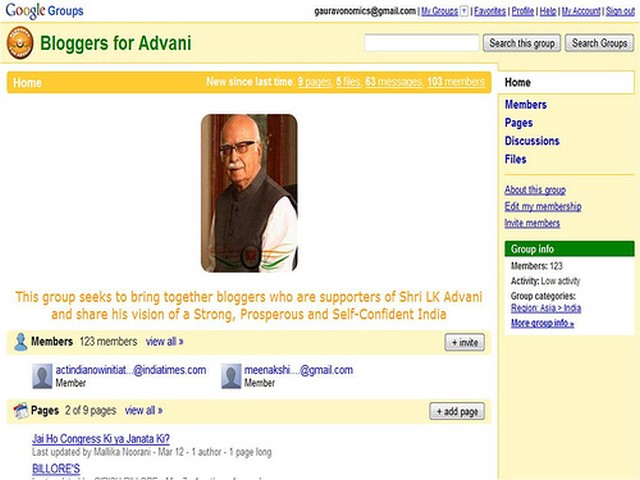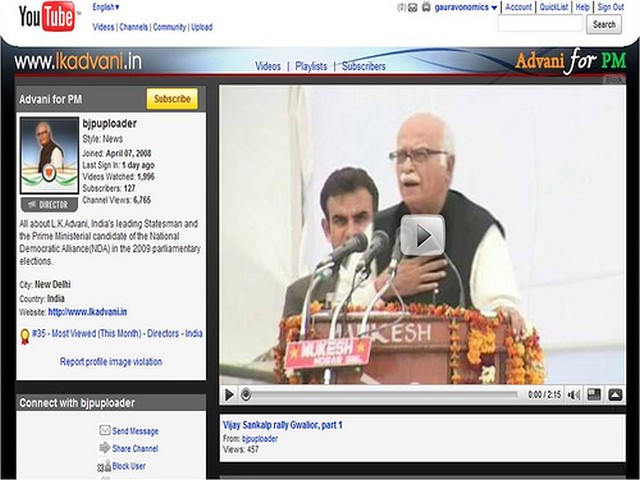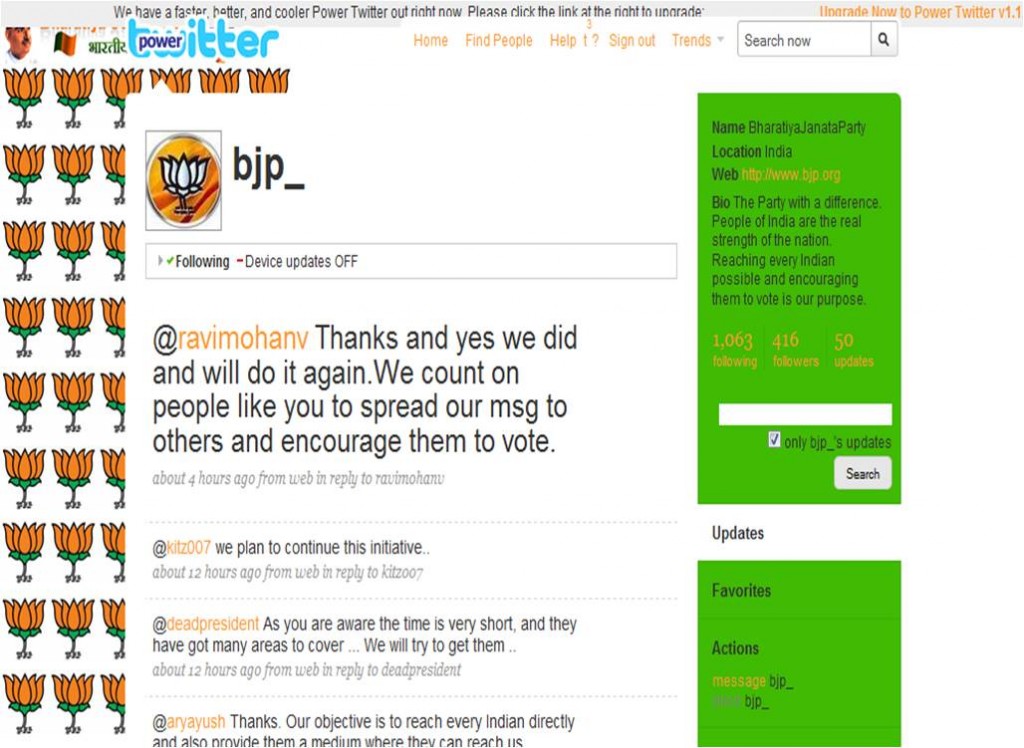This post is part of the Global Voices special coverage on the Elections in India 2009.
Politics in India is essentially local and India's voters elect their representatives based on small local and regional issues, instead of the big national issues. As a result, election rallies and door-to-door canvassing, supplemented by local hoardings and print ads in the vernacular languages have traditionally been at the core of election campaigning in India.
In 2004, the incumbent BJP broke away from this pattern with its aggressive nation-wide ‘India Shining’ campaign. It recruited advertising and PR agencies to manage its campaign, focused on the urban first time voter, advertised heavily on print and television, and allocated 5% of its campaign budget to an e-campaign, for revamping its campaign website, pushing out text messages, pre-recorded voice clips and emails to its database of 20 million email users and 20 million phone users, and offering campaign-related mobile ringtones for download (BBC/ BBC/ Rediff/ Hindu). The ‘India Shining’ campaign didn't work eventually, and Sonia Gandhi led Congress to a surprise victory, once again reaffirming the almost magical appeal of the Nehru-Gandhi family amongst India's voters. Many observers even attributed BJP's loss to its “elitist” ‘India Shining’ campaign (Live Mint).
In spite of its “failure”, BJP's India Shining campaign has set the pattern for all Indian election campaigns since then: spend 40-50% on print, 20% on outdoors, 15% on TV, 5%-10% on internet and mobile and the rest on radio, film theaters and on-ground activities (Live Mint).
What, then, has changed since 2004? For one, the demographic profile of India's electoral based has shifted. More than half of India's 1150 million population is younger than 25, 42 million new voters have entered the electorate since 2004, and, as a result of the newly delimited constituencies, the importance of urban votes has increased in the electoral collage. Not only that, the internet and mobile penetration in India has increased dramatically since 2004, from 26 million to 365 million for mobile, and from 16 million to 80 million for the internet. Even more importantly, shaken by the 11/26 Mumbai terrorist attack, and inspired by Barack Obama's success in the US elections, the young urban Indian is likely to step out to vote for the first time in India's recent electoral history. As a result, both BJP and Congress are targeting young, urban voters like never before. BJP and Congress, however, have adopted different tactic to appeal to this audience. While Congress is banking on the youthful appeal of Rahul Gandhi, the 39 year of scion of the Gandhi family, BJP has embarked on an aggressive 360 degree campaign, inspired by the Obama campaign (Chicago Tribune/ AFP/ Indian Express/ TOI/ Reuters).
While BJP's official website is nothing but a brochure, Lal Krishna Advani's website has several interesting features. To begin with, LK Advani's blog has been active since January 2009 and each of the ten odd posts have between 50 to 150 comments. Surprisingly, the Hindi version of LK Advani's blog has very few comments. The forum on LK Advani's website isn't much to look at, but it's doing well, with 6586 members, 2940 topics, and 9354 posts.
The Advani@Campus initiative seeks to build a grassroots volunteer campaign “to contact and mobilize young voters in thousands of college campuses across the country” (Telegraph/ DNA/ NDTV/ Indian Express). The focus on recruiting volunteers is reflected in a well-structured volunteer program. The tasks range from recruiting first time voters, promoting LK Advani's website and social media profiles, translating sections of the website, designing banner ads, and helping out with other campaign work. According to one report, BJP has recruited more than 7000 volunteers through the website (Business Standard).
Especially interesting is the Bloggers for Advani initiative run by Mallika Noorani. The initiative is coordinated through a Google Group (started based on a suggestion by yours truly), and encourages bloggers to display a Bloggers for Advani button and promote BJP's ideas on their blogs.
It seems that most of the social media initiatives on the Advani campaign are run by volunteers and encouraged by the campaign coordinators. In any case, it's difficult to identify which profiles or groups are official and which are unofficial. The official website links to a LK Advani Facebook page (with 390 supporters) and an Advani for PM Orkut group (with 960 members), but there are several other unofficial groups with similar memberships. The (official?) BJP Supporters Group on Orkut has 22,157 members. Similarly, there's confusion about whether the @BJP_ Twitter profile, which has 416 followers is indeed official.
A group which seems to work closely with the campaign team is the Friends of BJP group (Facebook/ Orkut), which includes several prominent professionals including Rajesh Jain and R K Mishra. Another unofficial website which is getting some traction is Join BJP.
Apart from these national level initiatives, several BJP leaders, including Gujarat chief minister Narendra Modi, Madhya Pradesh chief minister Shivraj Singh Chouhan and V K Malhotra also have well-designed websites. Narendra Modi and V K Malhotra also have Twitter profiles.
The BJP is also running an aggressive online ad campaign, primarily with Google, with search ads across as many as 200,000 keywords, placement ads across 50,000 websites, and banner ads across 2,000 websites. With a billion searches every month, BJP's campaign is expected to recah 75% of India's internet users (Live Mint/ Economics Times).
BJP is also planning to send one billion SMSes to about 250 million cellphone users, who are not enrolled in the Do-Not-Call registry. Overall, telecom operators expect to make an additional revenue of $10 million from an extra traffic of 3-4 billion SMSes sent by all the political parties, apart from money from from multimedia messages, songs and wallpapers (Economic Times/ Indian Express/ Financial Express).
Last week, the BJP also released a detailed 30-page IT Vision document (PDF) with much fanfare. The document is partly a road map to reform and partly a pre-election populist pipe dream. It promises to give the highest priority to developing IT infrastructure and leveraging it for better governance and inclusive development. Specifically, it promises to match China on all IT-related parameters within 5 years. While many observers have dismissed the document as pre-election populism, others have pointed out that it is a testament to BJP's forward looking thinking that it believes that it can win an election by promising to transform India into an IT super-power.
The Indian National Congress, on the other hand, seems to be stuck in the web 1.0 era. Both the official Congress website and the Congress Media websites are online brochures. The Vote for Congress portal, which was supposed to revolutionize its online campaign by providing the Congress candidates a platform to blog (Hindu/ TOI), is still not up. None of the senior Congress leaders — Sonia Gandhi, Rahul Gandhi, and Manmohan Singh — have a website and, what's worse, their URLs are owned by cyber-squatters (Indian Express). The party does want to set up 600 internet kiosks across the country (Hindu) but without engaging interactive content, their effectiveness might be limited.
Shashi Tharoor — author and former Under-Secretary-General of the United Nations — is perhaps the only Congress candidate to seriously leverage the web in his campaign, with presence on Facebook and Orkut (CIOL/ Sify). Former Karnataka chief minister SM Krishna has a Twitter profile. Some of the younger Congress candidates like Priya Dutt, Milind Deora (Facebook) and Sachin Pilot also have well-designed websites, but aren't really active on social media.
Several other regional parties have either set up, or revamped, their websites, in the run up to the general elections. The CPI-M (Live Mint/ Hindu/ Economic Times/ Indian Express) and Samajvadi Party websites seem to be the most well-designed. However, none of these websites are using social media tools, beyond asking for donations and newsletter subscriptions.
Many observers have pointed out that the digital campaigns by BJP and other Indian political parties are amateurish in comparison to Barack Obama's social media campaign (CIOL/ Networked World) and they are right. BJP's digital campaign can hardly be compared to Obama'a campaign, in terms of ambition, execution or results. The campaign is hardly going to change the course of the election; the election will still be decided in India's small towns and villages. But, even if it “fails”, the campaign will set a precedent for all future elections in India, just like the ‘India Shining’ campaign did, five years ago.
Cross-posted on Gauravonomics, my blog on social media and social change.













13 comments
It is ironic that political parties are interested in Information and Communication Technology (ICT) only to the extent it benefits them. They have nothing to do with the fact that India has bad cyber law, cyber security, cyber forensics, etc. Even the basic legal enablement of ICT systems in India is missing. The truth is that we are making India a safe heaven for cyber crimes. This is so despite the big claims by Government of India (GOI), Department of Information Technology (DIT), CDAC and other departments and partners of government. In the absence of public participation even this factual truth is buried deep below the files and documents managed by government. The ICT Failures in India would ultimately result in ICT Emergency In India. The ultimate question is should we be satisfied by the papers only growth in this regard or should we insist upon transparency and accountability?